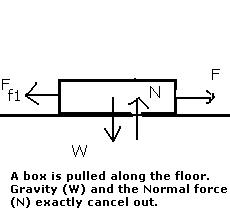
Definition: The resistance to motion which is called into play when it is attempted to slide one surface over another with which it is in contact. The frictional force opposing the motion is equal to the moving force up to a value known as the limiting friction. Any increase in the moving force will then cause slipping. Static friction is the value of the limiting friction just before slipping occurs. Kinetic friction is the value of the limiting friction after slipping has occurred. This is slightly less than the static friction. The coefficient of friction is the ratio of the limiting friction to the normal reaction between the sliding surfaces. It is constant for a given pair of surfaces. The energy lost due to friction is usually converted to heat.
Units: coefficient of friction, dimensionless; frictional force, newtons, N
Symbol: coefficient of friction: μ. friction: fN
Examples: An object of weight 10N sliding over a table with μk=0.1 experiences a force resisting its motion of 1N, as long as there are no other vertical forces on the object.
1 comment:
It's a nice static friction definition. Thanks for sharing it.
Post a Comment